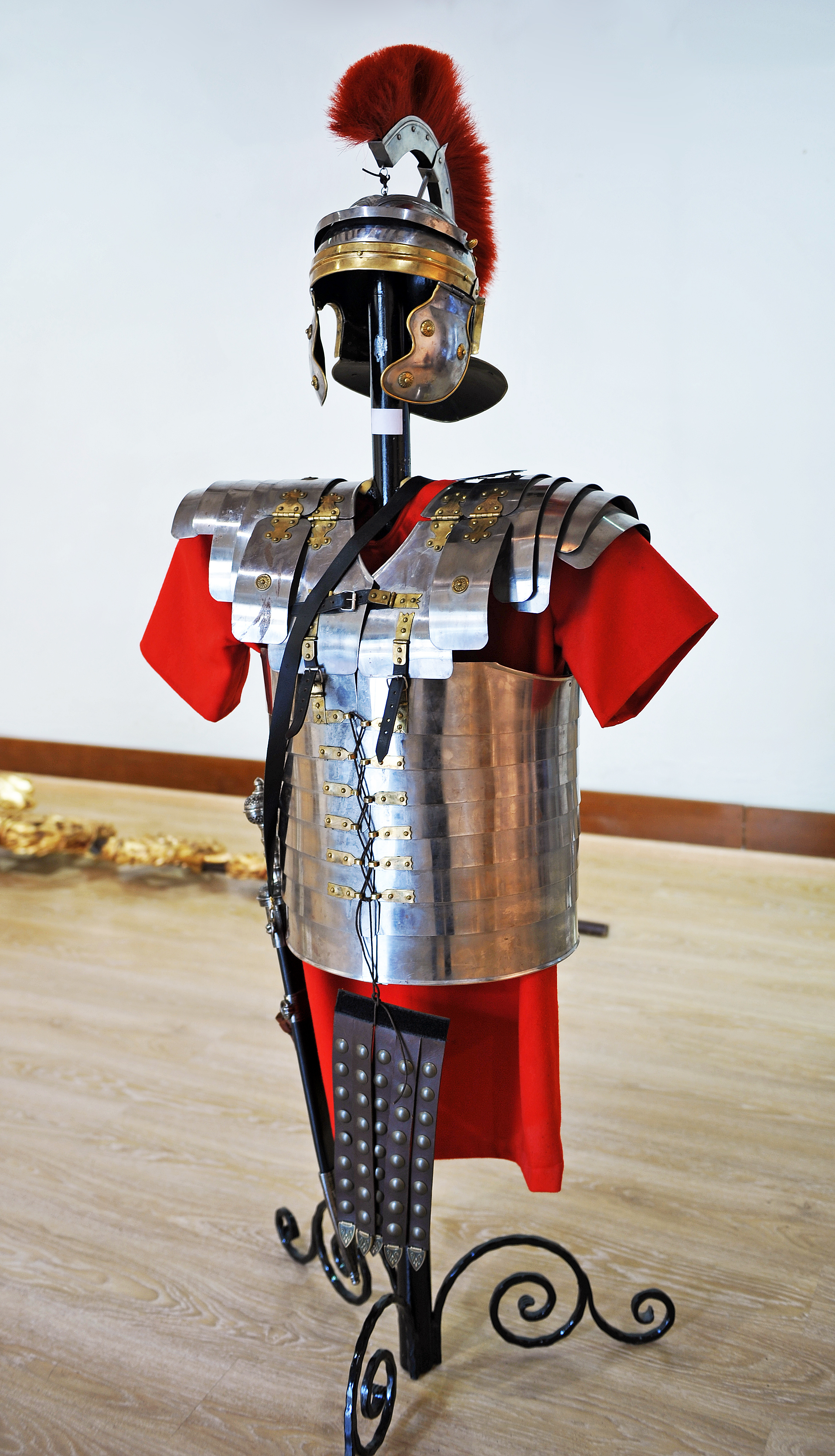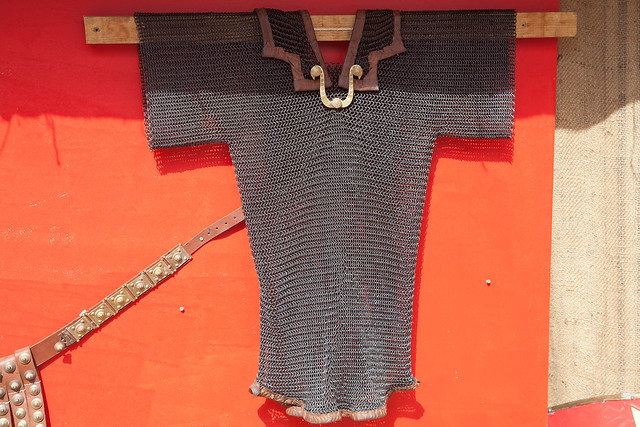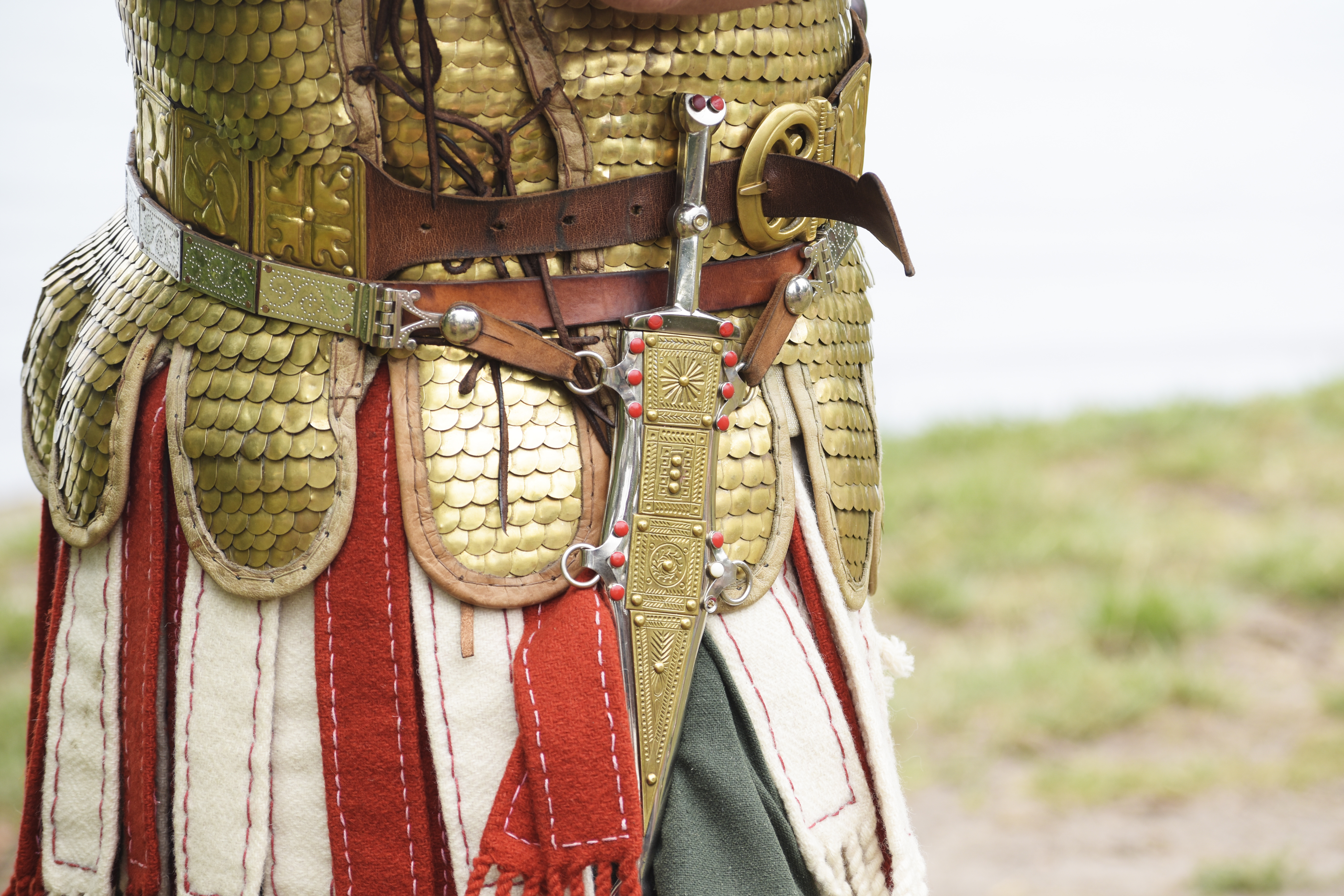
The body armor presented on a Roman Legionnaire, whether on ancient statues, modern re-enactors, or illustrations is usually the scaled plate armor referred to as Lorica Segmentata, a phrase that has been in use only since the 16th century.
Lorica Segmentata
The armor consists of horizontal scales, sort of like a lobster. Additional plates protect the shoulders.
Wikipedia says the insides of the plates were soft steel and the outside mild steel. The individual plates were hung on a leather harness with brass buckles. Later on rivets or hooks were used.

The armor fastened in front and back. The sections could be stored inside each other, allowing for compact storage.
Legionary: The Roman Soldier’s (Unofficial) Manual by Philip Matyszak explains a Legionaire would first put on a scarf to protect the neck and chest from being rubbed raw by the steel.
The plates required constant polishing to prevent rust.
The buckles would need lots of attention; they would be rust magnets. I think it was this book that said if a centurion was especially irritated with his company, he could take the troops on a march in the rain wearing full lorica segmentata which would then generate additional punishment because the wet steel would require hours and hours of polishing to prevent rust.
Before putting on the armor, The Romans in Britain website says a legionnaire would put on a subarmalis, or a padded jacket. It may have been made out of leather or linen with wool padding between layers.
Purpose of the subarmalis was to cushion a blow. Although the armor would stop or deflect a sword, the force of a blow would transmit the energy of the strike directly to the body, thus guaranteeing bruises plus risking broken bones or internal injuries. The padding of a subarmalis would cushion the shock.
Website says no examples of subarmalis have survived, which makes sense since one would expect leather and linen to have disintegrated after merely a few centuries.

Then the leather harness and segments could be put on.
The Lorica Segmentata was lighter than chain mail and easier to manufacture. With all those segments, it was flexible, allowing a legionnaire to move freely.
It provided superb protection from the shoulders to the waist or hips. This means the internal organs were protected from slashes, thrusts, stabs, or arrows. It would likely protect from the thrust of a javelin or spear but not from a thrown javelin or pilum. When thrown, those would have enough velocity to punch through armor. Shields provided protection from thrown missiles.
There are apparently several major types of Lorica Segmentata that have been recovered by archaeologists. Several articles suggest such armor was in use from around 10 B.C. to the early 4th century. Apparently that type of armor wasn’t used earlier and its use died out in early 300s.
By the way, this illustrates the limit of knowledge of the Roman era by historians. They don’t quite know when the use of Lorica Segmentata began, or ended, or why soldiers stopped wearing it, or exactly whether it was used only by legions or also auxiliaries, or how many different styles there were, or why different styles came into use.
Lorica Hamata

Chain mail, or Lorica Hamata, was worn by Roman soldiers from around the 3rd century BC well into the 4th century AD. That is a run of around 600 years.
Wikipedia says the Roman lorica hamatas were made from rings that were punched out of steel and then connected with cut, drawn wire that was riveted into a circle. Each riveted ring would connect four other rings.

The resulting armor was flexible and provided good protection. It was heavy though, weighing in at around 24 pounds.
The article says up to 30,000 rings may have been used to make one set of armor. It took two months of constant labor, so it was relatively expensive. On the other hand, after manufacture, it could then be used for a few decades.

Maintenance of lorica hamata armor was far easier than lorica segmentata. The Wikipedia article said merely wearing the lorica hamata provided enough friction to keep it rust free. The Matyszak book mentioned above said sets of chain mail could be put in a barrel with sand and rolled around a bit, getting the armor nice and clean.

Lorica Squamata
Scale armor, or Lorica Squamata, was also in use. Time frame isn’t quite as clear, with Wikipedia suggesting it was used during the Roman Republic (509 B.C. – 27 B.C.) and perhaps later. That hints that the lorica squamata was essentially replaced by the lorica hamata (chain mail) with lorica segmentata (plate armor) being widely used for a while.

Each scale was wired or laced to the adjacent scales. A row of scales was then sewn on to a fabric jacket one row above the next lower row.
Length would be down to mid-thigh according to the article. Illustration shows going to about the hip.
Archaeologists have found lots of lorica squamata fragments but no complete sets.
For more discussion of a Roman soldiers’ kit, check out other posts on Legionnaire equipment and weaponry:
- Introduction
- Balteus or cingulum– belt, with comment on pugio, a daggar
- Lorica Segmentata, Lorica Hamata, Lorica Squamata – body armor, i.e. breastplate
- Caligae – sandals
- Scutum – shield
- Gladius – sword
- Galea – helmet
- Pilum – javelin